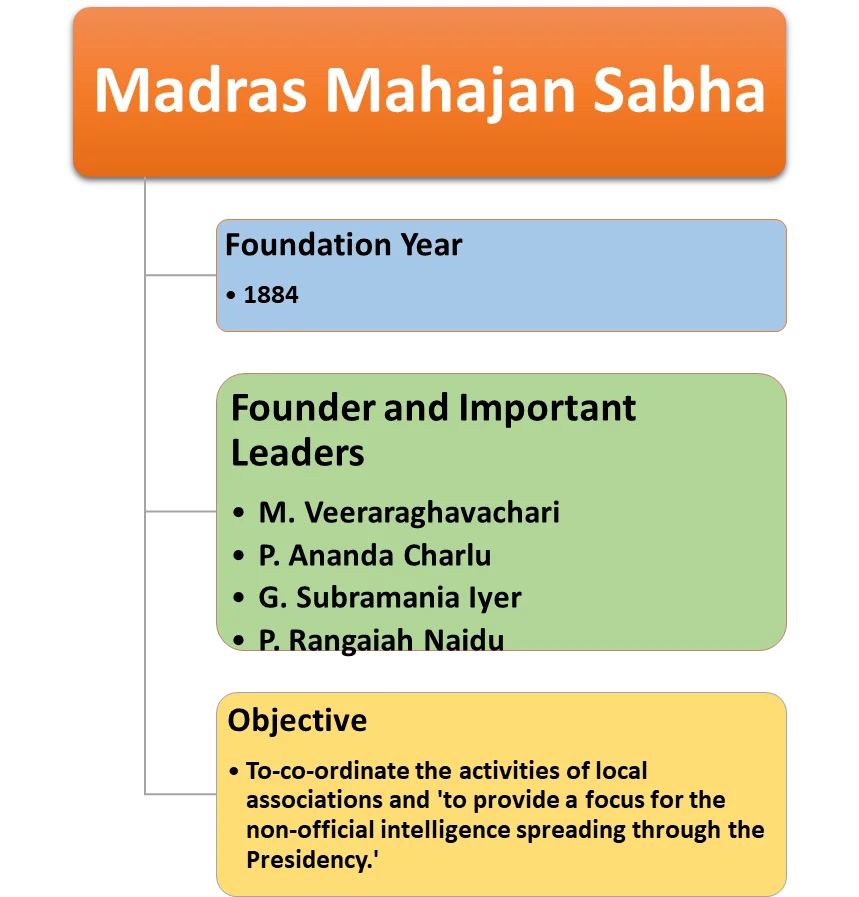A branch of the British Indian Association of Calcutta was established in Madras, named the Madras Native Association, which submitted a petition to Parliament before the passing of the Charter Act of 1853, articulating demands akin to those of the British India Association and Bombay Association. However, from its initiation, it was managed by certain officials, exhibited minimal vitality, lacked significant influence on public opinion, and faded into obscurity after 1857.
Madras Native Association (MNA)
It was founded in 1852 by Gajula Lakshminarasu Chetty. The Madras Native Association (MNA) marked a significant milestone as the first political association in the Madras presidency. In Madras, political activities remained at a low ebb after the demise of the Madras Native Association in 1862.
Objectives
- Advocacy for Landed Gentry: Serving as the primary outlet for the political grievances of the region’s landed gentry, who held discontent against the East India Company’s rule, the MNA played a crucial role in channeling and expressing their concerns.
- Response to Missionary Influence and Legislative Changes: Notably, the association’s establishment was driven by the need to counteract Christian missionary activities and legislative measures like the Lex Loci laws of 1850.
- These laws aimed to protect the property rights of individuals who converted to Christianity, prompting the formation of the MNA as a response to safeguard local interests and traditions.
Madras Mahajan Sabha
It was founded in 1884 under the leadership of M. Veeraraghavachari, P. Ananda Charlu, and G. Subramania Iyer. P. Rangaiah Naidu served as its inaugural president.

Objectives
- To free the country from British rule and to resolve national issues.
- Coordinating Local Associations: To coordinate the activities of local associations and ‘to provide a focus for the non-officials intelligence through the presidency’.
- Unifying Local Efforts: Beyond these overarching goals, the Sabha played a vital role in coordinating the activities of local associations, providing a cohesive focal point for non-official intelligence throughout the presidency.
- Advocacy and Reform: During its pivotal conference held from December 29-31, 1884, and January 1-2, 1885, the Sabha passionately advocated for the expansion of legislative councils, inclusive Indian representation, and the segregation of judicial and revenue functions.
- This marked a significant contribution to the ongoing dialogue on governance and representation in British India.
Outside the presidencies too, organized political life revolved around the new associations, like the Lahore Indian Association in Punjab or the Allahabad Peoples’ Association in the United Provinces.
Pre-Congress Campaigns
The Indian National Congress made its entry onto the political stage through a series of campaigns that encompassed diverse issues, including the call for the imposition of import duty on cotton in 1875.
- Advocacy and Opposition in Colonial Policies: Subsequent endeavors focused on significant causes such as advocating for the Indianisation of government services, opposing Lord Lytton’s Afghan adventure, protesting the Arms Act of 1878, and rejecting the Vernacular Press Act of the same year.
- Expansion of Political and Social Campaigns: The campaigns extended to championing the right to join volunteer corps, opposing plantation labour and the Inland Emigration Act(in 1881-82), supporting the Ilbert Bill(in 1883), and rallying for an All India Fund for Political Agitation(in 1885).
- Efforts in Britain and the Indian Civil Service Agitation: (Additionally, efforts were directed towards campaigning in Britain to garner support for pro-India parties and resisting the reduction in the maximum age for appearing in the Indian Civil Service.
- Notably, the Indian Association played a pivotal role in addressing the latter concern, leading an all-India agitation commonly known as the Indian Civil Service agitation(between 1877-80).
Apart from raising such public issues, which concerned all Indians across the regions, these associations also took an interest in the affairs of the peasantry.
- Participation in Regional Uprisings: Their involvement in the indigo riots in Bengal, in the Deccan riots in Poona, and the protests against water tax in the Chenab Canal Colony in Punjab.
- Social Reform and National Mobilization: Some of these organizations, like the Poona Sarvajanik Sabha, were involved in a variety of social work among the peasantry, like mobilizing famine relief or organizing arbitration courts.
-
- Through such mediation, the Indian peasants, so far locked away in their localised existence, were gradually connected to a wider national contest with colonial rule.
| Must Read | |
| Current Affairs | Editorial Analysis |
| Upsc Notes | Upsc Blogs |
| NCERT Notes | Free Main Answer Writing |
Conclusion
In conclusion, the 19th-century Indian political associations, from the aristocratic-dominated early phase to the emergence of an educated middle class, reflect the evolving aspirations of a nation under colonial rule. Associations like the British Indian Association and Bombay Association strategically voiced demands, shaping the discourse for increased representation and socio-political reforms. Their endeavours, navigating colonial challenges, laid a foundational narrative, contributing significantly to India’s subsequent quest for independence.
Sign up for the PWOnlyIAS Online Course by Physics Wallah and start your journey to IAS success today!

 GS Foundation
GS Foundation Optional Course
Optional Course Combo Courses
Combo Courses Degree Program
Degree Program











